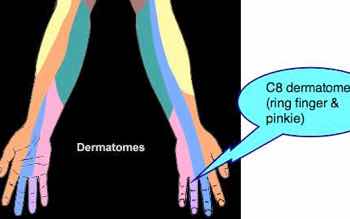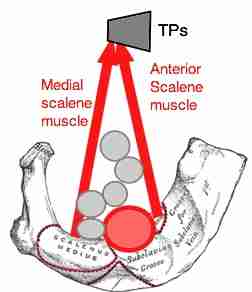- All You Need to Know
Spurling's test
Spurling's test is used daily at the chiropractic coalface when examining the patient with suspected nerve root pain.
More recently it is being called simply the Spurling Test.
An ache radiating down the arm from the neck is one of the most difficult and painful conditions treated in chiropractic clinics. It's a frequent sequela of a whiplash injury; it may occur immediately, or years later if there was injury to the joints of Luschka which then become arthritic.
There's a deep ache in a very specific part of the arm, called a dermatome, that pertains exactly to the outflow from one single nerve root.
If there is generalised pain in the limb, in most of the fingers, for example, then it is not likely that Spurling's test will be positive; it is probably not from a nerve root.
There is often tingling in the arm and hand too. The part may be hypersensitive to light touch or prick with a pin early on; later it becomes numb.
Then if the motor nerve is affected, one or more muscles may become weak; the triceps behind the upper arm is most commonly experiencing what is known as paresis. There is difficulty extending the elbow against resistance.
The history is an important part of the process; the experienced clinician may often make a pretty shrewd shot at the diagnosis without even examining the patient.

Nerve root pain
Nerve root pain is excruciating and it's never more miserable than when Spurling's test is strongly positive. You simply cannot escape the ache in your arm, which is often worse at night, no matter how you lie.
Whilst the chiropractic adjustment is the treatment of choice in my book, obviously I'm biased, use of a "cervical break" technique on the side of pain will often worsen the condition. Artful manipulation is based on an understanding of the anatomy and use of the correct methods of managing the condition.
Spurling test
Spurling's test is used to evaluate the patient with pain radiating down the arm.
An important adjunct to Spurling's test is the shoulder abduction relief sign. Does raising the arm above the head relieve the pain?
Equally, does carrying a heavy basket in the upper limb increase the pain and tingling in the arm and hand?
Together these are strong signs that would corroborate the positive test.
Alternatively, if raising the limb above the head increases the tingling in the arm and hand then one would suspect rather a condition involving the interscalene triangle; through this space in the lower neck pass important nerve structures, and the subclavian artery, giving mixed symptoms of deficient blood and nerve supply.
This most usually is caused by a first rib fixation and subsequent spasm of the anterior and medial scalene muscles; perhaps it's vice versa. Adjustment of these structures is the solution.
Another infrequent cause is a tumour in the apex of the lungs of smokers. Together it's known as the thoracic outlet syndrome.

Upper limb tension
Finally, the confirmation of Spurling's test that it is indeed a tethered root as it exits from the spine is done using the upper limb tension test. Mostly it's used to place stress on the median nerve; stretching out the arm causes an immediate tightness and frequently deep ache towards the fingers on the thumb side.
Chiropractic
The chiropractic profession is dedicated traditionally in the main to improving spinal health; that means adjusting subluxations that may be causing nerve irritation. In the lower neck that would sometimes provoke a positive Spurling's test. It's an ominous sign and not to be taken lightly. Surgery often looms if it's not carefully and correctly managed by both the patient and chiropractor.
I often find that too frequent manipulation is less helpful; I like to have a few treatments and then leave well alone for a week. The problem is that the patient is often in severe pain, and then rushes off to the doctor, ending up in surgery.
This too will pass, is the correct saying; for those willing to exhibit some patience in the face of severe pain in the neck and arm, the condition usually can be corrected.
In that interim period some gentle chiropractic treatment without frank manipulation may be the best course of action; holding back is my grasp of the situation but there's never an always or never. Each patient must be examined and managed according to your doctor's findings and experience, and instincts too. I'm a great believer in gut feel.
Cervical traction has a place in the management of arm pain when there's a positive Spurling's test, but the device has to be set up correctly with the right number of pillows under the head, and the correct angle of attack of the traction. This takes some willingness to be patient and try postures.
The weight of the traction is another variable that should be considered. Setting up the traction unit is an art in itself.
My rule of thumb is that should direct axial traction by your chiropractor bring immediate relief of the neck and arm pain, then this device will probably help too.
All in all, a pinched nerve in the neck with a positive Spurling's test, and increased pain with upper limb tension is one of the most testing conditions in the chiropractic clinic. Ask any surgeon and they will confirm it challenges them too.
Hoffman's sign
The examiner snaps the distal phalanx of the middle finger into flexion. If the thumb and index finger approximate, that is Hoffman's sign.
Useful links
- Go from Spurlings test to our tingling in arms and hands homepage.
- Return to our neck pain page.
- Shoulder abduction relief sign.
- Slipped disc in neck.
- Thoracic outlet syndrome
When browsing these links use right click and "Open Link in New Tab", or you may get a bad gateway signal.
Did you find this page useful? Then perhaps forward it to a suffering friend. Better still, Tweet or Face Book it.
